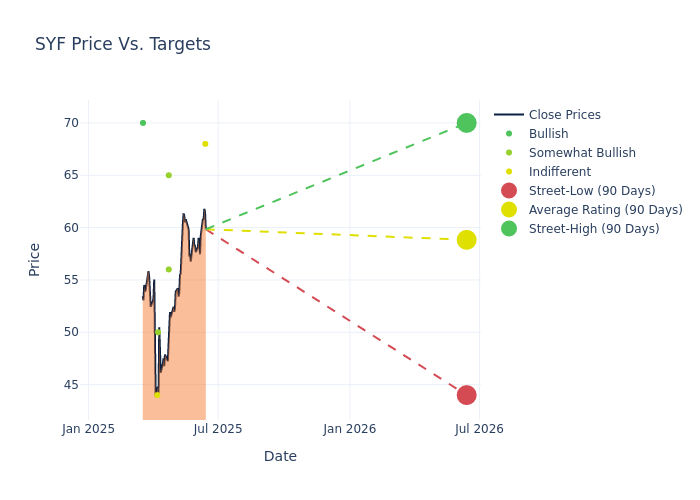Beyond The Numbers: 9 Analysts Discuss Synchrony Financial Stock
In the preceding three months, 9 analysts have released ratings for Synchrony Financial (NYSE:SYF), presenting a wide array of perspectives from bullish to bearish.
The table below offers a condensed view of their recent ratings, showcasing the changing sentiments over the past 30 days and comparing them to the preceding months.
| Bullish | Somewhat Bullish | Indifferent | Somewhat Bearish | Bearish | |
|---|---|---|---|---|---|
| Total Ratings | 1 | 4 | 4 | 0 | 0 |
| Last 30D | 0 | 0 | 1 | 0 | 0 |
| 1M Ago | 0 | 0 | 0 | 0 | 0 |
| 2M Ago | 0 | 2 | 1 | 0 | 0 |
| 3M Ago | 1 | 2 | 2 | 0 | 0 |
In the assessment of 12-month price targets, analysts unveil insights for Synchrony Financial, presenting an average target of $60.56, a high estimate of $70.00, and a low estimate of $44.00. Experiencing a 17.92% decline, the current average is now lower than the previous average price target of $73.78.

Interpreting Analyst Ratings: A Closer Look
The standing of Synchrony Financial among financial experts is revealed through an in-depth exploration of recent analyst actions. The summary below outlines key analysts, their recent evaluations, and adjustments to ratings and price targets.
| Analyst | Analyst Firm | Action Taken | Rating | Current Price Target | Prior Price Target |
|---|---|---|---|---|---|
| Brian Foran | Truist Securities | Raises | Hold | $68.00 | $63.00 |
| Brian Foran | Truist Securities | Lowers | Hold | $57.00 | $65.00 |
| Donald Fandetti | Wells Fargo | Lowers | Overweight | $65.00 | $70.00 |
| John Pancari | Evercore ISI Group | Lowers | Outperform | $56.00 | $64.00 |
| Richard Shane | JP Morgan | Lowers | Overweight | $50.00 | $76.00 |
| Jeff Adelson | Morgan Stanley | Lowers | Equal-Weight | $44.00 | $82.00 |
| Donald Fandetti | Wells Fargo | Lowers | Overweight | $70.00 | $85.00 |
| Brian Foran | Truist Securities | Lowers | Hold | $65.00 | $77.00 |
| Alex Scott | Goldman Sachs | Lowers | Buy | $70.00 | $82.00 |
Key Insights:
- Action Taken: Analysts adapt their recommendations to changing market conditions and company performance. Whether they 'Maintain', 'Raise' or 'Lower' their stance, it reflects their response to recent developments related to Synchrony Financial. This information provides a snapshot of how analysts perceive the current state of the company.
- Rating: Unveiling insights, analysts deliver qualitative insights into stock performance, from 'Outperform' to 'Underperform'. These ratings convey expectations for the relative performance of Synchrony Financial compared to the broader market.
- Price Targets: Analysts provide insights into price targets, offering estimates for the future value of Synchrony Financial's stock. This comparison reveals trends in analysts' expectations over time.
Assessing these analyst evaluations alongside crucial financial indicators can provide a comprehensive overview of Synchrony Financial's market position. Stay informed and make well-judged decisions with the assistance of our Ratings Table.
Stay up to date on Synchrony Financial analyst ratings.
Get to Know Synchrony Financial Better
Synchrony Financial, originally a spinoff of GE Capital's retail financing business, is the largest provider of private-label credit cards in the United States by both outstanding receivables and purchasing volume. Synchrony partners with other firms to market its credit products in their physical stores as well as on their websites and mobile applications. Synchrony operates through three segments: retail card (private-label and co-branded general-purpose credit cards), payment solutions (promotional financing for large ticket purchases), and CareCredit (financing for elective healthcare procedures).
Synchrony Financial's Economic Impact: An Analysis
Market Capitalization Analysis: Above industry benchmarks, the company's market capitalization emphasizes a noteworthy size, indicative of a strong market presence.
Decline in Revenue: Over the 3M period, Synchrony Financial faced challenges, resulting in a decline of approximately -0.29% in revenue growth as of 31 March, 2025. This signifies a reduction in the company's top-line earnings. In comparison to its industry peers, the company trails behind with a growth rate lower than the average among peers in the Financials sector.
Net Margin: Synchrony Financial's net margin surpasses industry standards, highlighting the company's exceptional financial performance. With an impressive 19.8% net margin, the company effectively manages costs and achieves strong profitability.
Return on Equity (ROE): The company's ROE is below industry benchmarks, signaling potential difficulties in efficiently using equity capital. With an ROE of 4.79%, the company may need to address challenges in generating satisfactory returns for shareholders.
Return on Assets (ROA): Synchrony Financial's ROA is below industry standards, pointing towards difficulties in efficiently utilizing assets. With an ROA of 0.61%, the company may encounter challenges in delivering satisfactory returns from its assets.
Debt Management: Synchrony Financial's debt-to-equity ratio is below the industry average at 1.11, reflecting a lower dependency on debt financing and a more conservative financial approach.
Analyst Ratings: What Are They?
Analysts work in banking and financial systems and typically specialize in reporting for stocks or defined sectors. Analysts may attend company conference calls and meetings, research company financial statements, and communicate with insiders to publish "analyst ratings" for stocks. Analysts typically rate each stock once per quarter.
Some analysts also offer predictions for helpful metrics such as earnings, revenue, and growth estimates to provide further guidance as to what to do with certain tickers. It is important to keep in mind that while stock and sector analysts are specialists, they are also human and can only forecast their beliefs to traders.
Which Stocks Are Analysts Recommending Now?
Benzinga Edge gives you instant access to all major analyst upgrades, downgrades, and price targets. Sort by accuracy, upside potential, and more. Click here to stay ahead of the market.
This article was generated by Benzinga's automated content engine and reviewed by an editor.
 Wall Street Journal
Wall Street Journal